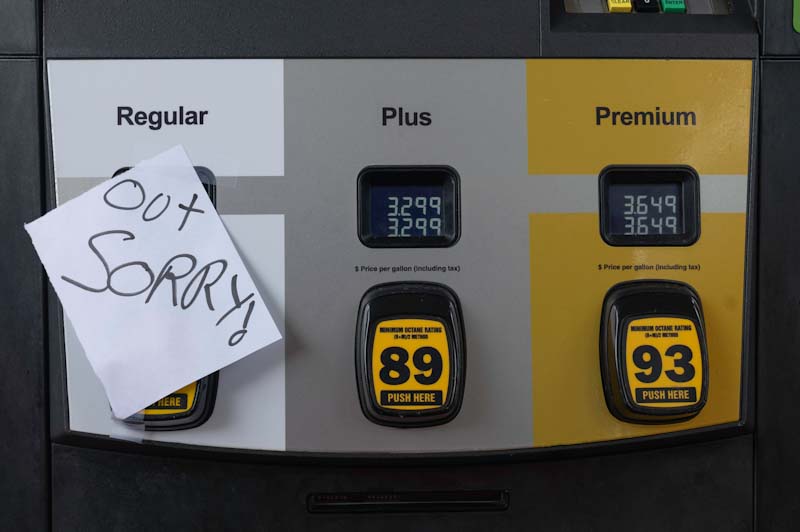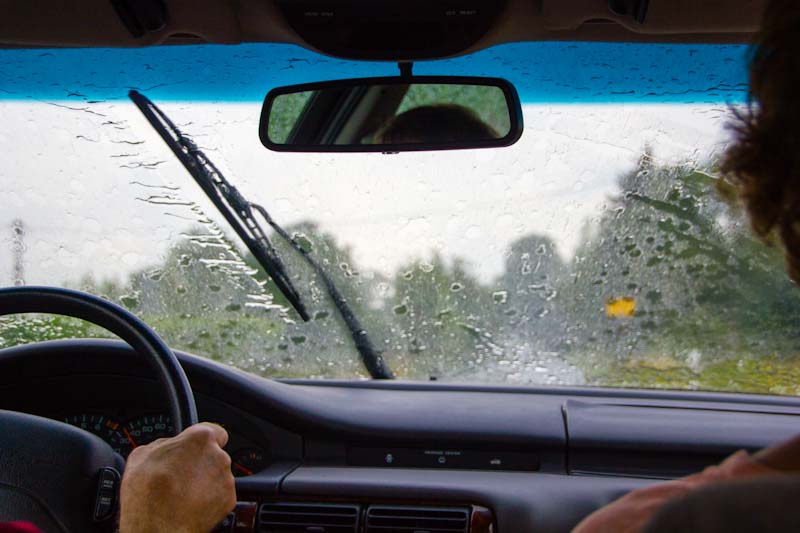The world has had many near-SHTF scenarios in the last few years, including a global pandemic, a spike in natural disasters and a widespread economic recession.
With gas prices reaching record highs, fuel scarcity is yet another potential problem you must prepare for. Here are 10 strategies for dealing with it if things continue to go south.
1. Practice Fuel-Efficient Driving Habits
How you drive your vehicle has a significant impact on its fuel consumption. If a gas crisis emerges, you can’t afford to continue wasteful habits like idling and speeding. Start practicing these fuel-efficient driving habits now so you’ll be prepared if SHTF:
- Drive within the speed limit.
- Remove excess weight from the vehicle.
- Minimize your idling time.
- Control your acceleration and deceleration.
- Anticipate the pace of traffic.
- Open the windows instead of relying on A/C.
- Use cruise control on highways.
You should also determine the most optimal route each time you drive. This strategy is more complicated than you think, because the fastest way isn’t always the best.
For example, going through the city might be the quickest way to get from point A to point B, but the constant starts and stops burn more fuel. A trip through the suburbs may take longer, but it consumes less gas because driving at a consistent speed puts less strain on the vehicle.
2. Use Other Transportation Methods
Start using other transportation methods to get around your local area. Use public transportation, hail a ride-sharing service, take a bicycle or simply walk. Anything that doesn’t take precious fuel from your limited supply is a worthwhile alternative. Your daily commute is a good place to start, as it makes up a large portion of your collective consumption.
You should also discuss carpooling with your co-workers so everyone can save gas on their daily commutes. A group of people can only hope to survive a SHTF scenario through communication and collaboration.
If your job is flexible enough, you might even be able to switch to a remote work position and eliminate your daily commute altogether. This one change will save you dozens of gallons of fuel in the long run.
3. Stay Proactive With Vehicle Maintenance
You need to stay proactive with maintenance for your car to remain as fuel-efficient as possible. That means you must spend more time on preventive maintenance tasks such as checking the tire pressure, changing the filters and replacing the fluids based on the manufacturer’s recommendations.
You also can’t afford to ignore minor car problems or they might lead to a serious mechanical failure. The last thing you want during a SHTF scenario is an unexpected breakdown. Learn to troubleshoot common engine problems so your car stays healthy and reliable.
Portable Device Generator – Learn How To Build Your Own Energy Generator!
4. Stockpile Fuel
The sky-high gas prices are one indicator of a possible SHTF fuel crisis, but we still don’t know when it might occur. It could happen in a few years or tomorrow. The best option is to prepare for the worst and keep your gas tanks full with frequent top-offs.
You should also fill up your spare gas cans with at least three months’ worth of fuel, as gasoline has a shelf life of up to six months. Label each tank by date so you can fill up your vehicles with the oldest can.
If and when fuel becomes scarce, all your essential vehicles and tools will have a healthy fuel supply. While everyone else is fighting each other at gas stations, you will be sitting at home thanking yourself for having the foresight to maintain your stockpile. However, you still have to use it wisely.
5. Track Your Fuel Consumption
Tracking your fuel consumption will be crucial to making your supply last. Three essential tasks will ensure accurate tracking: recording your miles driven, logging each refill and communicating with your loved ones. You can’t afford to casually take from your limited supply in a crisis. Tracking helps you devote every gallon to something worthwhile, such as driving for more supplies or heating your home. You won’t want to waste a single drop.
6. Bolster Your Home and Auto Security
In a SHTF scenario, the people with the most resources have the brightest targets on their backs. You can be sure people will try to siphon gas from you, especially if they know you have a full tank and a stockpile hidden on your property. They might even be desperate enough to steal your vehicle and other essential supplies while they’re at it.
You must bolster your house and vehicle security to protect your hard-earned supply. Your home system should include cameras, light fixtures and motion-sensor alarms to ward off trespassers. These auto security devices would make great additions to your vehicles:
- Steering wheel lock: This prevents the steering wheel from moving far enough to complete a turn.
- Brake and clutch lock: This keeps the pedals locked in place.
- Wheel clamp: This stops the wheel from spinning.
- Immobilizers: Fuse cutoffs and kill switches prevent the vehicle from starting until a hidden button is pressed.
- GPS tracker: Thisallows the owner to track their stolen car’s location.
Even if you live in a safe crime-free community now, there’s no guarantee it will remain so in a fuel crisis. Your next-door neighbor might become a threat. Security is one of the greatest investments you can make to prepare for a SHTF scenario.
7. Invest in Emergency Fuel Sources
Petroleum-based fuel shouldn’t be your only option. After all, we use gas for more than just driving. It’s essential for generating electricity, cooking food and heating homes. You need to start investing in multiple emergency fuel sources to increase your supply as much as possible. Start stockpiling these materials:
- Firewood: Every serious survivalist should have a dry, well-seasoned collection of firewood on their property.
- Charcoal: Charcoal can only burn outdoors because of the high amounts of carbon monoxide it produces, but it’s also more efficient than regular wood.
- Alcohol: Ethanol, isopropyl and denatured alcohol are all highly flammable and have indefinite shelf lives. A bottle of liquor also works if you’re in a pinch.
- Gel fuel: Gel fuel consists of 90% isopropyl alcohol and 10% gelling agent. It doesn’t spill or emit smoke and can stay lit for up to three hours, making it the perfect stealth option if you’re trying to keep a low profile.
These alternative fuel sources are more widely available than gasoline, so you should start using them for daily tasks more often. Every drop of gas will be precious once SHTF, so you might as well become an expert with these other options now.
8. Use Alternative Energy Sources
You shouldn’t rely 100% on a singular energy source. These alternative options are becoming more common on off-grid homesteads worldwide:
- Solar energy: This energy source is unlimited, sustainable and easy to install. A few solar panels or a photovoltaic kit are the two main solar power setups.
- Wind energy: Installing wind turbines and generators takes a lot of time and manpower, but the energy supply is unlimited if you live in a windy area.
- Hydroelectric energy: A micro-hydro system heavily depends on location. If you’re lucky enough to have a running water source nearby, it can provide enough energy to power a small village.
Based on these brief descriptions, solar energy is clearly the easiest to implement for most people. However, every home has different needs. Wind or hydroelectric energy might be the most practical option for your climate and location. Evaluate your property and start laying the groundwork to install one of these systems.
9. Stock up on Essential Goods
Following all these strategies means you’ve done everything you can to prepare for a fuel shortage. What now? In a SHTF scenario, you need to prepare for everything. You can’t call yourself a true survivalist if you don’t have a shelf or bunker full of food, water, first-aid supplies and other essential survival items. Start stocking up now because a crisis can start in the blink of an eye.
10. Grow Your Own Food
The ability to grow your own food will be a major advantage if a fuel scarcity situation occurs. Trucks won’t be able to deliver fresh food, supply chains will shut down and grocery stores will have slim pickings. The only person you can rely on is yourself.
You don’t need much space to start a vegetable garden, and small livestock like chickens and pigs are fantastic resources for homesteads with limited square footage. Live off the land to stay fed and healthy in a desperate situation.
Survival of the Fittest
Many of us have the privilege of living in comfort, but a fuel crisis can take that away. Given the current state of the oil market and the global economy, a SHTF scenario doesn’t seem so farfetched. If such a situation occurs, it will be survival of the fittest.
Don’t let yourself get too comfortable. Apply these 10 tips to your survival checklist so you and your loved ones are prepared for fuel scarcity and all the problems it can bring.









One who drives thousands of mile each year on business | October 20, 2022
|
There is some good advice here but one suggestion was absolutely wrong: using cruise control to save gas.
If you drive on perfectly flat roads it might work ok but if you have any hills at all – even small hills – then your car will naturally slow down as you climb the hill and your cruise control will cause your motor to automatically rev to a higher rpm to maintain the preset speed.
You’ll get significantly worse gas mileage using cruise control – unless, as I said, you drive where there are zero hills.
One Who Drives Thousands Of Mile Each Year On Business | October 20, 2022
|
Sorry to be a naysayer but another mistake I see here is frequently topping off your gas tank.
That’s ok if prices are rising fast but it’s a big mistake if you want to increase your gas mileage. A full tank of gas is very heavy and lugging all that extra weight around will significantly reduce your gas mileage.
MaxxSr | October 30, 2022
|
I drive for a living repairing equipment in peoples homes. It is a small one person Business. I can go thru 20 Gallons of Diesel a day. today that was $110.00. I can use that in a day or some times two. Vehicle used is a 1ton Diesel Van. I have to carry a bunch of spare parts as needed. So yes this small business person drives for a living
Shaun | November 1, 2022
|
Some good info here, but less than perfect, as mentioned above by some. Another little oopsie is the windows down vs. air conditioning use. The wind resistance and buffeting of the open windows is enough to reduce mileage more than the use of the a/c button on the dashboard. Aerodynamics designed into the vehicles (most of them, anyway) will give better results on fuel consumption than keeping the drag of the compressor on the fan belt off. There’s already enough torque on the belt from the engine revolution that that one pulley won’t make a significant difference.
Eggshell between my foot and the gas pedal keeps my mileage up! 🙂